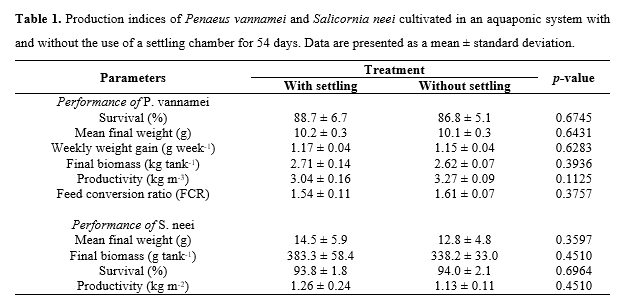EFFECT OF THE USE OF A SETTLING CHAMBER IN THE CULTIVATION OF Penaeus vannamei AND Salicornia neei IN BIOFLOC-BASED AQUAPONICS
Introduction
Although freshwater aquaponics is the most practiced and studied, integrating the cultivation with halophyte plants (salt-tolerant) can be an alternative to the limited use of water for food production and soil salinization . S pecies such as Salicornia neei —commonly known as salicornia or sea asparagus—are of great interest in the gl obal market for gourmet cuisine. The design of aquaponic systems often varies based on production objectives and the species being cultivated. To optimize performance, it is essential to understand the dynamics of solids production and manage nutrient-rich wastewater effectively, ensuring its efficient reuse for plant growth. Given the importance of managing residual nutrients and protecting plant roots from possible negative effects caused by suspended solids, this study aimed to evaluate the use of a settling chamber in a bio floc-based aquaponic system for the production of marine shrimp Penaeus vannamei and the halophyte Salicornia neei, and to assess its effects on sludge production.
Material and methods
The experiment was conducted over a 54-day period, at the Marine Shrimp Laboratory (LCM) of the Federal University of Santa Catarina, southern Brazil.
To evaluate the effects of using a settling chamber in the aquaponic system, two treatments were tested : one with settling and one without settling. Each aquaponic experimental unit comprised a circular polyethylene tank (800 L useful volume) for shrimp cultivation and a hydroponic bench for plant growth . The shrimp tanks were equipped with a heater, aeration hose, and four vertical artificial substrates. In the treatment with settling, a cylindrical fiberglass settling chamber with a conical bottom (90 L capacity) was attached.
The aquaponics structure was constructed based on the design by Pinheiro et al. (2017), with modi fications. The hydroponic bench consisted of four PVC pipes arranged side by side on wooden supports. Each bench had 0.33 m² of planting area, with 28 seedlings of S. neei per experimental unit . In the treatment without settling, water was continuously pumped from the shrimp tank to the hydroponic bench at a flow rate of 3.0 L min-1 using a submerged pump and returned to the tank by gravity. In the treatment with settling, water was pumped continuously to the center of the settling chamber, allowing solids to settle along the chamber’s conical bottom . Overflow water was then distributed into each irrigation channel and returned to the shrimp tank by gravity . To maintain the proper concentration of sus pended solids, every thirty minutes the solids accumulated in the settling chamber were pumped back to the tank for 40 seconds using an electric pump connected to the bottom outlet of the settling chamber, at a flow rate of 15 L min-1.
One day before the beginning of the experiment, the tanks and settling chambers were filled with biofloc water from a shrimp nursery tank. Each tank was stocked with 300 shrimp (average weight of 1.20 ± 0.08 g), representing a stocking density of 375 shrimp m-3.
Results and discussion
During the 54-day trial, the reduction of suspended solids in the treatment with settling led to an increase in TAN and NO2 levels, while the concentration of NO3 remained stable. Although water quality parameters were more stable in the treatment without settling, no significant differences were observed between the treatments regarding plant and shrimp production indices (Table 1).
One of the concerns of growing plants in aquaponics with BFT is the management of the solids concentration in the water, as these can s everely affect the roots and impact the absorption of nutrients . However, the continuous use of the settling chamber can break the microbial aggregates into small non-settleable particles, more difficult to control . In the treatment with settling, there was a thick layer of floating solids probably broken during the water pumping and sludge return to the tank. Thus, the reduction in the concentration of to tal suspended solids and settleable solids may be responsible for decreasing the biomass of nitrifying bacteria in this treatment (Hu et al., 2015; Pinheiro et al., 2017). In the treatment with settling, the reduction of the TSS concentration led to the gradual increase of TAN and NO2 in the water, since lower solids levels may disrupt the nitrification process, leading to an accumulation of these compounds (Schveitzer et al., 2024).
This study demonstrated, under the experimental conditions presented, the via bility of aquaponic cultivation of P. vannamei and S. neei in biofloc systems without the need for a settling chamber to reduce solids before the water passes through the hydroponic bench, thereby simplifying the system. Moreover, the absence of a settling chamber before the hydroponic bed resulted in more stable water quality parameters. Although the system without the settling chamber exhibited higher concentrations of suspended solids, this did not hinder the growth of either the plants or the shrimp. Nevertheless, the eventual use of a settling chamber remains necessary to maintain suspended solid levels within a range suitable for marine shrimp cultivation, particu larly in aquaponic systems with longer production cycles.
References
Hu, Z.; Lee, J.W.; Chandran , K.; Kim, S.; Brotto, A.C.; Khanal , S.K. Effect of Plant Species on Nitrogen Recovery in Aquaponics. Bioresour Technol 2015, 188, 92–98, doi:10.1016/j.biortech.2015.01.013.
Pinheiro, I.; Arantes , R.; Espírito Santo, C.M. do; Vieira, F. do N.; Lapa , K.R.; Gonzaga, L.V.; Fett, R.; Barcelos -Oliveira, J.L.; Seiffert, W.Q. Productio n of the Halophyte Sarcocornia ambigua and Pacific White Shrimp in an Aquaponic System with Biofloc Technology. Ecol Eng 2017, 100, 261–267, doi:10.1016/j.ecoleng.2016.12.024.
Schveitzer , R.; Baccarat, R.F.C.; Gaona , C.A.P.; Wasielesky , W.; Arantes , R. Concentration of Suspended Solids in Superintensive Culture of the Pa cific White Shrimp Litopenaeus v annamei with Biofloc Technology (BFT): A Review. Rev Aquac 2024, 16, 785–795, doi:10.1111/RAQ.12867.

